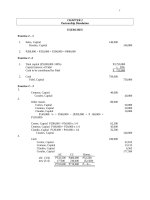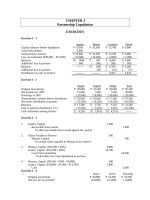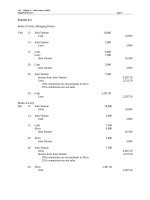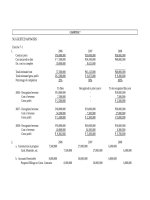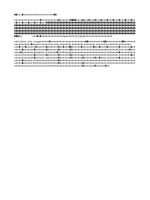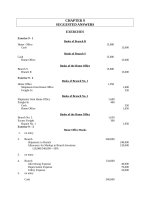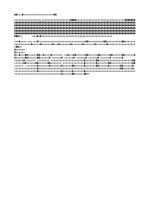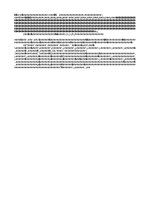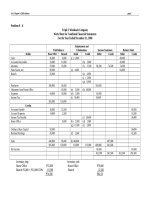Solution manual managerial accounting by cabrera 2010 chapter 08 answer
Bạn đang xem bản rút gọn của tài liệu. Xem và tải ngay bản đầy đủ của tài liệu tại đây (81.6 KB, 9 trang )
MANAGEMENT ACCOUNTING (VOLUME I) - Solutions Manual
CHAPTER 8
COST CONCEPTS AND CLASSIFICATIONS
I.
Questions
1. The phrase “different costs for different purposes” refers to the fact that
the word “cost” can have different meanings depending on the context
in which it is used. Cost data that are classified and recorded in a
particular way for one purpose may be inappropriate for another use.
2. Fixed costs remain constant in total across changes in activity, whereas
variable costs change in proportion to the level of activity.
3. Examples of direct costs of the food and beverage department in a hotel
include the money spent on the food and beverages served, the wages
of table service personnel, and the costs of entertainment in the dining
room and lounge. Examples of indirect costs of the food and beverage
department include allocations of the costs of advertising for the entire
hotel, of the costs of the grounds and maintenance department, and of
the hotel general manager’s salary.
4. The cost of idle time is treated as manufacturing overhead because it is
a normal cost of the manufacturing operation that should be spread out
among all of the manufactured products. The alternative to this
treatment would be to charge the cost of idle time to a particular job
that happens to be in process when the idle time occurs. Idle time often
results from a random event, such as a power outage. Charging the
cost of the idle time resulting from such a random event to only the job
that happened to be in process at the time would overstate the cost of
that job.
5. a. Uncontrollable cost
b. Controllable cost
c. Uncontrollable cost
6. Product costs are costs that are associated with manufactured goods
until the time period during which the products are sold, when the
product costs become expenses. Period costs are expensed during the
time period in which they are incurred.
8-1
Chapter 8 Cost Concepts and Classifications
7. The most important difference between a manufacturing firm and a
service industry firm, with regard to the classification of costs, is that
the goods produced by a manufacturing firm are inventoried, whereas
the services produced by a service industry firm are consumed as they
are produced. Thus, the costs incurred in manufacturing products are
treated as product costs until the period during which the goods are
sold. Most of the costs incurred in a service industry firm to produce
services are operating expenses that are treated as period costs.
8. Product costs are also called inventoriable costs because they are
assigned to manufactured goods that are inventoried until a later period,
when the products are sold. The product costs remain in the finished
goods inventory account until the time period when the goods are sold.
9. A sunk cost is a cost that was incurred in the past and cannot be altered
by any current or future decision. A differential cost is the difference in
a cost item under two decision alternatives.
10. a.
b.
c.
d.
Direct cost
Direct cost
Indirect cost
Indirect cost
11. The two properties of a relevant cost are:
1. it differs between the decision options
2. it will be incurred in the future
12. The three types of product costs are:
1. direct materials – the materials used in manufacturing the product,
which become a physical part of the finished product.
2. direct labor – the labor used in manufacturing the product.
3. factory overhead – the indirect costs for materials, labor, and
facilities used to support the manufacturing process, but not used
directly in manufacturing the product.
13. The three types of manufacturing inventories are:
1. materials inventory – the store of materials used in the
manufacturing process or in providing the service.
8-2
Cost Concepts and Classifications Chapter 8
2. work in process inventory – accounts for all costs put into the
manufacturing of products that are started but not complete at the
financial statement date.
3. finished goods inventory – the cost of goods that are ready for sale.
14. Direct materials include the materials in the product and a reasonable
allowance for scrap and defective units, while indirect materials are
materials used in manufacturing that are not physically part of the
finished product.
II. Exercises
Exercise 1 (Schedule of Cost of Goods Manufactured and Sold; Income
Statement)
Requirement 1
Amazing Aluminum Company
Schedule of Cost of Goods Manufactured
For the Year Ended December 31, 2005
Direct material:
Raw-material inventory, January 1.............
Add: Purchases of raw material.................
Raw material available for use....................
Deduct: Raw-material inventory,
December 31
P 60,000
250,000
P310,000
70,000
Raw material used
P240,000
Direct labor.........................................................
Manufacturing overhead:
Indirect material
400,000
P 10,000
Indirect labor
25,000
Depreciation on plant and equipment
100,000
Utilities
25,000
Other
30,000
8-3
Chapter 8 Cost Concepts and Classifications
................................................................
................................................................
Total manufacturing overhead
190,000
Total manufacturing costs..................................
Add: Work-in-process inventory, January 1....
Subtotal...............................................................
.......................................................................
Deduct: Work-in-process inventory,
December 1...................................................
Cost of goods manufactured..............................
P830,000
120,000
P950,000
115,000
P835,000
Requirement 2
Amazing Aluminum Company
Schedule of Cost of Goods Sold
For the Year Ended December 31, 2005
Finished goods inventory, January 1.........................................
Add: Cost of goods manufactured............................................
Cost of goods available for sale................................................
Deduct: Finished goods inventory, December 31...................
Cost of goods sold......................................................................
P150,000
835,000
P985,000
165,000
P820,000
Requirement 3
Amazing Aluminum Company
Income Statement
For the Year Ended December 31, 2005
Sales revenue..............................................................................
Less: Cost of goods sold...........................................................
Gross margin..............................................................................
Selling and administrative expenses.........................................
Income before taxes...................................................................
Income tax expense....................................................................
Net income .................................................................................
P1,105,000
820,000
P 285,000
110,000
P 175,000
70,000
P 105,000
Exercise 2
Cost Item
a. Transportation-in costs on materials
8-4
Fixed (F)
Variable (V)
Period (P)
Product (R)
Cost Concepts and Classifications Chapter 8
purchased
b. Assembly-line workers’ wages
c. Property taxes on work in process
inventories
d. Salaries of top executives in the
company
e. Overtime premium for assembly
workers
f. Sales commissions
g. Sales personnel office rental
h. Production supervisory salaries
i. Controller’s office supplies
j. Executive office heat and air
conditioning
k. Executive office security personnel
l. Supplies used in assembly work
m. Factory heat and air conditioning
n. Power to operate factory equipment
o. Depreciation on furniture for sales staff
p. Varnish used for finishing product
q. Marketing personnel health insurance
r. Packaging materials for finished product
s. Salary of the quality control manager
who checks work on the assembly line
t. Assembly-line workers’ dental
insurance
Exercise 3 (Cost Classifications; Manufacturer)
1.
2.
3.
4.
5.
6.
7.
8.
9.
a, d, g, i
a, d, g, j
b, f
b, d, g, k
a, d, g, k
a, d, g, j
b, c, f
b, d, g, k
b, c and d*, e and f and g*, k*
* The building is used for several purposes.
10. b, c, f
8-5
V
V
R
R
V
F
R
P
V
R
V
F
F
F
F
P
P
R
P
P
F
V
F
V
F
V
F
V
P
R
R
R
P
R
P
R
F
F
R
R
Chapter 8 Cost Concepts and Classifications
11.
12.
13.
14.
b, c, h
b, c, f
b, c, e
b, c and d†, e and f and g†, k†
†
The building that the furnace heats is used for several purposes.
15. b, d, g, k
Exercise 4 (Economic Characteristics of Costs)
1.
2.
3.
4.
5.
6.
marginal cost
sunk cost
average cost
opportunity cost
differential cost
out-of-pocket cost
Exercise 5 (Cost Classifications; Hotel)
1.
2.
3.
4.
5.
6.
7.
8.
a, c, e, k
b, d, e, k
d, e, i
d, e, i
a, d, e, k
a, d, e, k
d, e, k
b, d†, e, k
†
Unless the dishwasher has been used improperly.
9. h
10. a, d, e*, j
* The hotel general manager may have some control over the total space
allocated to the kitchen.
11.
12.
13.
14.
i
j
a, c, e
e, k
8-6
Cost Concepts and Classifications Chapter 8
Exercise 6
Pickup Truck Output
3,000 trucks
P 29,640,000
39,200,000
4,500,000
13,660,000
P 87,000,000
6,000 trucks
P 59,280,000
39,200,000
9,000,000
13,660,000
P121,140,000
9,000 trucks
P 88,920,000
39,200,000
13,500,000
13,660,000
P155,280,000
Selling price per truck
46,000
40,100
35,900
Unit cost
29,000
20,190
17,253
Profit per truck
17,000
19,910
18,647
Variable production costs
Fixed production costs
Variable selling costs
Fixed selling costs
Total costs
III. Problems
Problem 1
The relevant costs for this decision are the differential costs. These are:
Opportunity cost or lost wages (take home)
[P1,500 x 70% x 12 months]........
P12,600
Tuition......................................................
2,200
Books and supplies..................................
300
Total differential costs...................... P15,100
Room and board, clothing, car, and incidentals are not relevant because
these are presumed to be the same whether or not Francis goes to school.
The possibility of part-time work, summer jobs, or scholarship assistance
could be considered as reductions to the cost of school. If students are
familiar with the time value of money, then they should recognize that the
analysis calls for a comparison of the present value of the differential aftertax cash inflows with the present value of differential costs of getting the
education (including the opportunity costs of lost income).
Problem 2
8-7
Chapter 8 Cost Concepts and Classifications
Requirement (a)
Only the differential outlay costs need be considered. The travel and other
variable expenses of P22 per hour would be the relevant costs. Any
amount received in excess would be a differential, positive return to Pat.
Requirement (b)
The opportunity cost of the hours given up would be considered in this
situation. Unless Pat receives more than the P100 normal consulting rate,
the contract would not be beneficial.
Requirement (c)
In this situation Pat would have to consider the present value of the
contract and compare that to the present value of the existing consulting
business. The final rate may be more or less than the normal P100 rate
depending on the outcome of Pat’s analysis.
Problem 3
Utilities for the bakery
Paper used in packaging product
Salaries and wages in the bakery
Cookie ingredients
Bakery labor and fringe benefits
Bakery equipment maintenance
Depreciation of bakery plant and equipment
Uniforms
Insurance for the bakery
Boxes, bags, and cups used in the bakery
Bakery overtime premiums
Bakery idle time
Total product costs in pesos
2,100
90
19,500
35,000
1,300
800
2,000
400
900
1,100
2,600
500
66,290
Problem 4
Administrative costs
Rent for administration offices
Advertising
8-8
1,000
17,200
1,900
Cost Concepts and Classifications Chapter 8
Office manager’s salary
Total period costs in pesos
13,000
33,100
Problem 5
Requirement (a)
Sunk costs not shown could include lost book value on traded assets,
depreciation estimates for new investment, and interest costs on capital
needed during facilities construction.
Requirement (b)
The client might be used to differential cost as a decision tool, and believes
(correctly) that use of differential analyses has several advantages --- it is
quicker, requires less data, and tends to give a better focus to the decision.
The banker might suspect the client of hiding some material data in order to
make the proposal more acceptable to the financing agency.
IV. Multiple Choice Questions
1.
2.
3.
4.
5.
6.
B
D
B
A
C
D
7.
8.
9.
10.
11.
12.
C
D
C
C
A
C
13. D
14. D †
15. B †
16. A †
17. C †
18. C
*
19.
20.
21.
22.
23.
24.
A
A*
B
B
C
C
25.
26.
27.
28.
29.
30.
C
B
B
A **
A
B
Controllable costs are those costs that can be influenced by a specified
manager within a given time period.
** The answer assumes absorption costing method is used.
†
Supporting Computations
14. P60 + P10 + P18 + P4 = P92
16. P60 + P10 + P18 + P32 = P120
15. P32 + P16 = P48
17. P4 + P16 = P20
8-9
